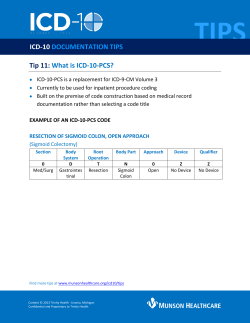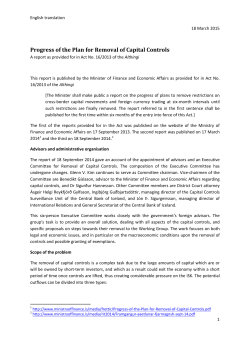
Ileosigmoid knotting: a report of cases two N. J. Jebbin
Ileosigmoid knotting: a report of two cases N. J. Jebbin Department of Surgery, University of Port Harcourt Teaching Hospital, Port Harcourt, Nigeria Correspondence to: Dr N. J. Jebbin (E-mail: njjebbin@yahoo.com) Abstract Background: Ileosigmoid knotting (ISK) is a rare cause of acute intestinal obstruction with high morbidity and mortality. The diagnosis is rarely made preoperatively because of its infrequency and the variations in presentation. Aim: To report two cases managed by the author, which will hopefully increase awareness of this condition. Case Reports: The first was a 51-year-old man who presented with a sudden onset of colicky lower abdominal pain, which later became generalized. His pulse rate was 100 beats/minute while his blood pressure was 80/60 mmHg.There was mild abdominal distension with absent bowel sounds. The second was a 50-year-old man with a sudden onset of generalized colicky abdominal pain, abdominal distension and vomiting. His pulse rate was 120 beats/minute and the blood pressure 80/50 mmHg. His bowel sounds were markedly reduced. Introduction Ileosigmoid knotting is an unusual and rare cause of intestinal obstruction. It is more commonly seen in parts of Africa, Asia, and the Middle East but less so in other parts of the world like the UK where 1, 2 reports are sporadic . Parker first described the condition in 1845; since then, over 260 cases have been reported from different parts of the world, but 2 the exact incidence is not known . It occurs commonly in men in their 4th decade but has been reported in children also, including a neonate3, 4. This is a report of two cases of ISK managed by the author in Mile One Hospital, Port Harcourt, Nigeria. The literature was reviewed. Port Harcourt Medical Journal 2007; 1: 197-200 They were resuscitated accordingly. In both patients, exploratory laparotomy revealed a copious amount of sero-sanguinous fluid in the peritoneal cavity with ileosigmoid knotting, and extensive gangrene involving the distal ileum and the sigmoid colon. In the first patient, the caecum was involved in the knot and therefore also gangrenous. Each of them had a sigmoid colectomy with a right hemicocetomy. The first patient died of adult respiratory distress syndrome while the other had an uneventful recovery. In the patient who died, surgery was done on the third day of onset of symptoms. Conclusion: A high index of suspicion, aggressive resuscitation, and prompt surgical intervention are indispensable for a successful outcome. Key Words: Ileosigmoid knotting, Gangrene, Right hemicolectomy, Sigmoid colectomy Case reports Case 1 A 51-year-old man presented with a sudden onset of colicky lower abdominal pain, which later became generalized. The pain was associated with vomiting of recently ingested food and constipation. He visited a private clinic, where he was treated for about ten hours with no improvement. He therefore went to Mile One Hospital, Port Harcourt for reevaluation. Physical examination revealed an ill looking, pale middle-aged man in mild respiratory and painful distress. His pulse rate was100 beats/minute, regular with moderate volume. His blood pressure was 80/60 mmHg. The abdomen was mildly distended with generalized tenderness. 197 Ileosigmoid knotting: a report of two cases The bowel sounds were hardly audible. A provisional diagnosis of acute intestinal obstruction was made. He was then resuscitated with cr ystalloids, broad-spectr um antibiotics (ceftriazone, gentamycin and metronidazole), and a naso-gastric tube was passed. Plain erect/supine radiographs of the abdomen revealed distended loops of small and large bowel with multiple air/fluid levels. An exploratory laparotomy carried out the following day revealed a copious sero-sanguinous fluid and an ileo-sigmoid knotting with gangrene involving the sigmoid colon, distal third of the ileum and caecum (Figure1). A sigmoid colectomy with primary colo-colic anastomosis and extended right hemicolectomy was perfor med. Unfortunately, the patient died three days later from adult respiratory distress syndrome. N. J. Jebbin 80/50mmHg. The abdomen was mildly distended with generalized tenderness and hyperactive bowel sounds. A diagnosis of acute intestinal obstruction was made and he was resuscitated with crystalloids, nasogastric suction and broad spectrum antibiotics (ceftriazone, gentamycin and metronidazole). An exploratory laparotomy performed the same day revealed a copious amount of serosanguinous fluid with ileosigmoid knotting and extensive gangrene involving the distal half of the ileum and sigmoid colon. An extended right hemicolectomy with ileocolic anastomosis and sigmoid colectomy with primary colo-colic anastomosis were done. His postoperative period was uneventful except for a few bouts of diarrhoea and he was discharged 10 days after surgery. He was lost to follow-up after two visits. Discussion Figure 1. Gangrenous bowel Case 2 A 50-year-old man presented with a sudden onset of generalized colicky abdominal pain, abdominal distension, and vomiting of six hours duration. On examination, he was covered with sweat, pale and dehydrated. His pulse rate was 120 beats/minute with poor volume. The blood pressure was Port Harcourt Medical Journal 2007; 1: 197-200 Ileosigmoid knotting is a very rare and curious cause of intestinal obstruction, occurring in men in their 4th decade3. It is relatively uncommon in females5. It is also referred to as compound volvulus or double volvulus but recently Raveenthiran has suggested that the correct terminology should be compound 2 volvulus . The aetiology of ISK is not very clear but anatomic and dietary factors have mainly been incriminated. These include a long small intestinal mesentery with a freely mobile small bowel, a long sigmoid loop on a narrow pedicle, and the consumption of a high bulk diet in the presence of an empty small bowel. Meckel's diverticulum has 6 been reported to be present in 14-53% of cases while a relaxed anterior abdominal wall, as commonly seen in postpartum women has also 7 been implicated . Shepherd's description of the pathogenesis of 3 ISK has been universally accepted . In his description, loops of ileum descend into the left paracolic gutter and wrap around the sigmoid colon, both becoming distended sooner or later. With time, both loops of ileum and sigmoid become strangulated, the latter more frequently so. Gangrene ensues eventually, and may extend to the 198 Ileosigmoid knotting: a report of two cases terminal ileum, occasionally involving the caecum and rarely, the proximal ascending colon1, 3. The diagnosis of ISK is infrequently made preoperatively, this being possible only in about 1, 7 20% of patients . This is because the symptoms are often nonspecific. Any patient previously in a good state of health and developing a sudden onset of colicky abdominal pain, other features of intestinal obstruction, and in a shock state, all occurring in 3,8 rapid succession should arouse a suspicion of ISK . The two cases in this report presented in this manner. White blood cell count usually shows 9 leucocytosis due to gangrene and it is thus not specific for ISK. Plain abdominal radiographs may show characteristic double closed loop obstruction, with the sigmoid on the right upper quadrant and the small bowel loops on the left but this is only an 1,7 occasional finding . More often, the picture is either that of simple sigmoid volvulus or small bowel obstruction but the former is predominant. Computerized tomographic features of ISK have been described. These include the 'whirl sign', created by the twisted intestine and mesentery, and medial deviation of the descending colon with a beak appearance on its medial border10. This investigation was not available in Port Harcourt at the time. Survival in this rare but serious malady hinges on aggressive resuscitation and early surgical intervention 1,11 . The diagnosis of intestinal obstruction without a definite pathology is a sufficient indication for a laparotomy. It has been observed that accurate diagnosis is not an end in itself but a means to providing an appropriate treatment12. The surgical option is dictated by the findings at laparotomy. With viable intestinal loops, untying the knot alone is considered sufficient, and recurrence is uncommon3 . Other authors advocate resection of the sigmoid colon in all cases13 or mesosigmoidoplasty11 to avert recurrence. When the bowel loops are gangrenous, most authors recommend the knot should not be unraveled as this can lead to bowel perforation and septic shock 1,3. Gangrene of both loops of bowel will demand en block resection of the knot and double primary Port Harcourt Medical Journal 2007; 1: 197-200 N. J. Jebbin anastomosis of ileal and sigmoid ends3,7. However, if gangrene extends to less than 10cm from the ileocaecal junction, a right hemicolectomy is recommended1. This was the option adopted in the cases presented. Other options include closure of the distal ileal stump and end to side ileo-colic anastomosis 3, 7. The disadvantage of this is that the bypassed portion of the intestine, known as a blind loop, often initiates a cascade of problems known as 14 the blind loop syndrome . Thus it is advised when the patient's intra operative condition is precarious. The prognosis of ISK depends on early 2,8 diagnosis and eventual surgery . The mortality rates of non-gangrenous ISK range from 6.8%-8%. For gangrenous cases, however, they vary from 20%-100%15. Septic shock is the commonest cause of death13. The first patient presented died from ARDS following septic shock. Poor prognostic factors include age over 60 years, duration of symptoms longer than 24 hours, and extensive bowel gangrene1. Conclusion Ileo-sigmoid knotting is a rare cause of intestinal obstruction. Its diagnosis often tasks even the clinical acumen of experienced surgeons. This is therefore very often made at laparotomy. The prognosis used to be very poor but currently, with early diagnosis, aggressive resuscitation, potent broad-spectrum antibiotics and advances in anaesthesia with modern post-operative intensive care, the outcome is improving. References 1 Alver O, Oren D, Tireli M, Kayabasi B, Akdemir D. Ileosigmoid knotting in Turkey. Review of 68 cases. Dis Colon Rectum 1993; 36: 1139-1147. 2 Raveenthiran V. The ileosigmoid knot: new observations and changing trends. Dis Colon Rectum 2001; 44: 1196-1200. 3 Shepherd JJ. Ninety-two cases of ileosigmoid knotting in Uganda. Br J Surg 1967; 54: 561-566. 199 Ileosigmoid knotting: a report of two cases 4 Chirdan LB, Ameh EA. Sigmoid volvulus and ileosigmoid knotting in children. Pediatr Surg Int 2001; 17: 636-637. 5 Scott QJ. Ileosigmoid knot and sigmoid volvulus. S Afr J Surg 1973; 11: 29-32. 6 Kusumoto H, Yoshida M, Takahashi I, Anai H, Maehara Y, Sugimachi K. Complications and diagnosis of Meckel's diverticulum in 776 patients. Am J Surg 1992; 164: 382-383. 7 Puthu D, Rajan N, Shenoy GM, Pai SU. The ileosigmoid knot. Dis Colon Rectum 1991; 34: 161-166. 8 Odelola MA, Bode CO, Anuma HM. Compound volvulus in the paediatric age group: a report of two cases from Lagos. Lagos J Surg 1999; 2: 27-28. 9 Bizer LS, Liebling RW, Delany HM, Gliedman ML. Small bowel obstruction: the role of nonoperative treatment in simple intestinal Port Harcourt Medical Journal 2007; 1: 197-200 N. J. Jebbin obstruction and predictive criteria for strangulation obstruction. Surgery 1981; 89: 407413. 10 Lee SH, Park YH, Won YS. The ileosigmoid knot: CT findings. AJR Am J Roentgenol 2000; 174: 685-687. 11 Akgun Y. Management of ileosigmoid knotting. Br J Surg 1997; 84: 672-673. 12 Todd JW. The superior clinical acumen of the old physicians, a myth. Lancet 1953; 1: 482-484. 13 Wapnick S. Treatment of intestinal volvulus. Ann R Coll Surg Engl 1973; 53: 57-61. 14 Mortensen NJ, Jones O. The small and large intestines. In: Russell RC, Williams NS, Bulstrode CJ, eds. Bailey and Love’s short practice of Surgery. 24th edition. London: Arnold, 2004: 1153-1185. 15 Hsu ML. Ileosigmoid knot. J R Coll Surg Edin 1979; 24: 28-29. 200
© Copyright 2025










![[ PDF ] - journal of evolution of medical and dental sciences](http://cdn1.abcdocz.com/store/data/000689186_1-31401e945a50574a207096550cf965e9-250x500.png)

